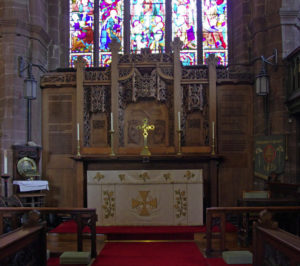This large, but rather uninspiring building in the centre of Cambridge is the university church. The first church was built around 1209 and students gathered here for lecture and to have degrees conferred. It was also the meeting place until the University Senate building was built in the C18th.
The present building dates form the end of the C15th and was funded by Richard III and Henry VII. The tower is later. The galleries were added in the C18th to accommodate the large numbers of the university who were required to attend the University Sermon. This was the largest public building in Cambridge and could seat over 1200 people. It underwent a major restoration in the C19th carried out by Gilbert Scott.
From the outside, it is a very plain building with solid west tower and battlemented nave and side aisles. It’s most attractive feature is the west door with its ogee arch and carving.
Inside, tall slender arches with decorative carving, separate nave and side aisles, giving a sense of height to the nave. The oak roof is the original. When it showed signs of decay in the C17th, it was preserved by a new roof was constructed above it and the two tied together. The galleries along the north and south walls do give the church a rather oppressive feel with their dark wood and low ceilings over the side aisles. They also block out a lot of the light coming from the side aisle windows.
At the back of the church is the highly carved font is dated 1632.
The pews are C19th dating from the Temple Moore restoration when massive three decker pulpit and the the box pews were torn out. They have rather nice carved poppy heads and arms. He replaced the three decker pulpit by a smaller pulpit mounted on wheels which can be moved into the centre of the church for the University Sermon.
The church is unusual as it has two organs, one above the west door, and another in the chancel. The chancel organ is used for regular services. That at the west end is owned and maintained by the University and is played at University services.
The carved wood and gilded Risen Christ above the altar was carved by Alan Durst and placed here in 1960. In the centre is Christ surrounded by alpha and omega, the beginning and the end and the symbols of the four evangelists.
On the north side of the chancel is St Andrew’s Chapel. The east window is a memorial to the dead of the Great War. The fibre glass statue next to it represents the Risen Christ.
The church is open daily and does get a regular stream of visitors. It is a place to pop into when passing rather than a church to specifically search out. The post code is CB2 3PQ and the grid reference is TL 448585.
There are more pictures “here.”:http://wasleys.org.uk/eleanor/churches/england/cambridgeshire/index.html









